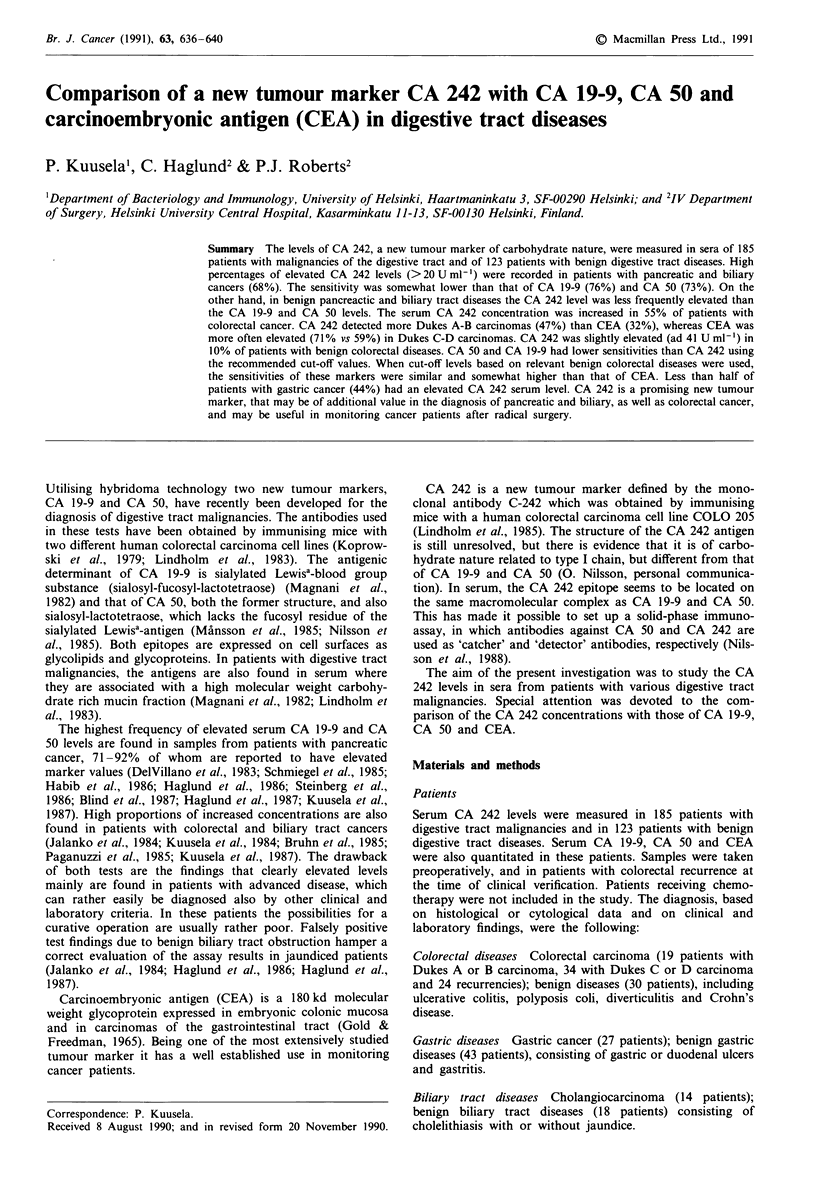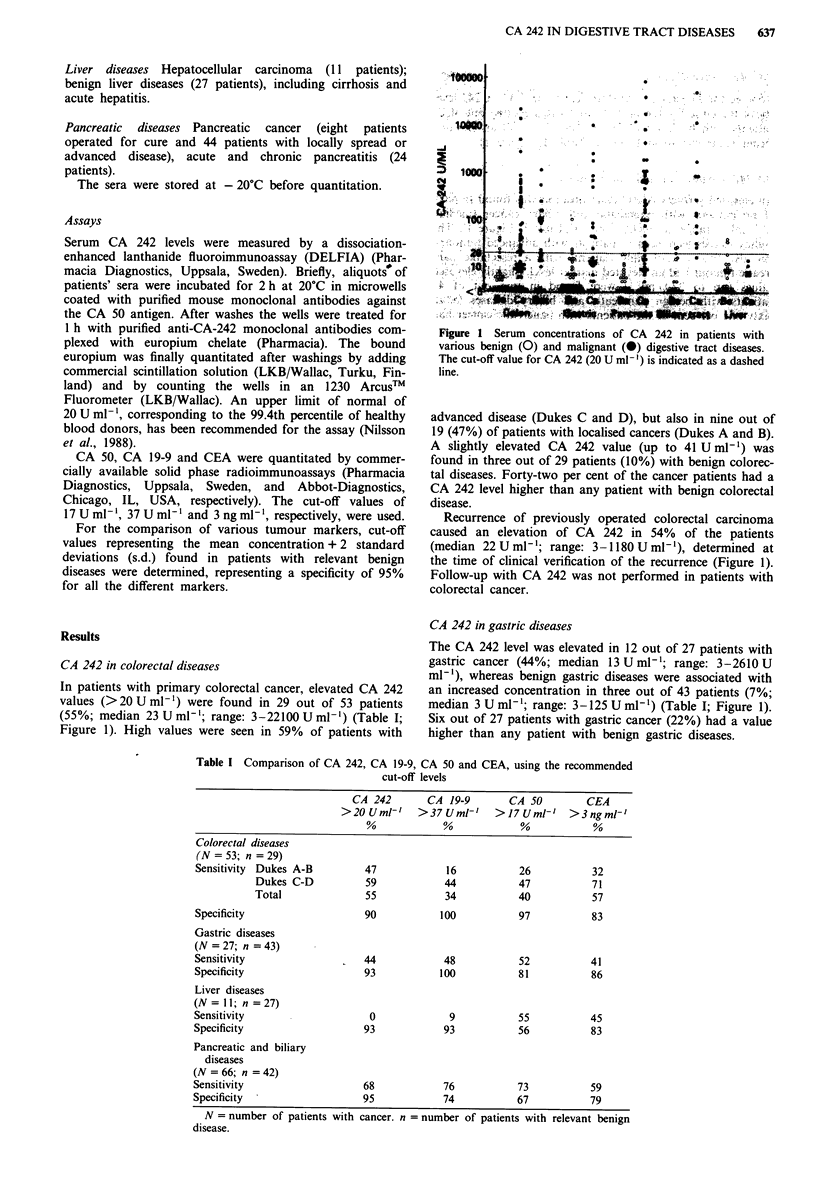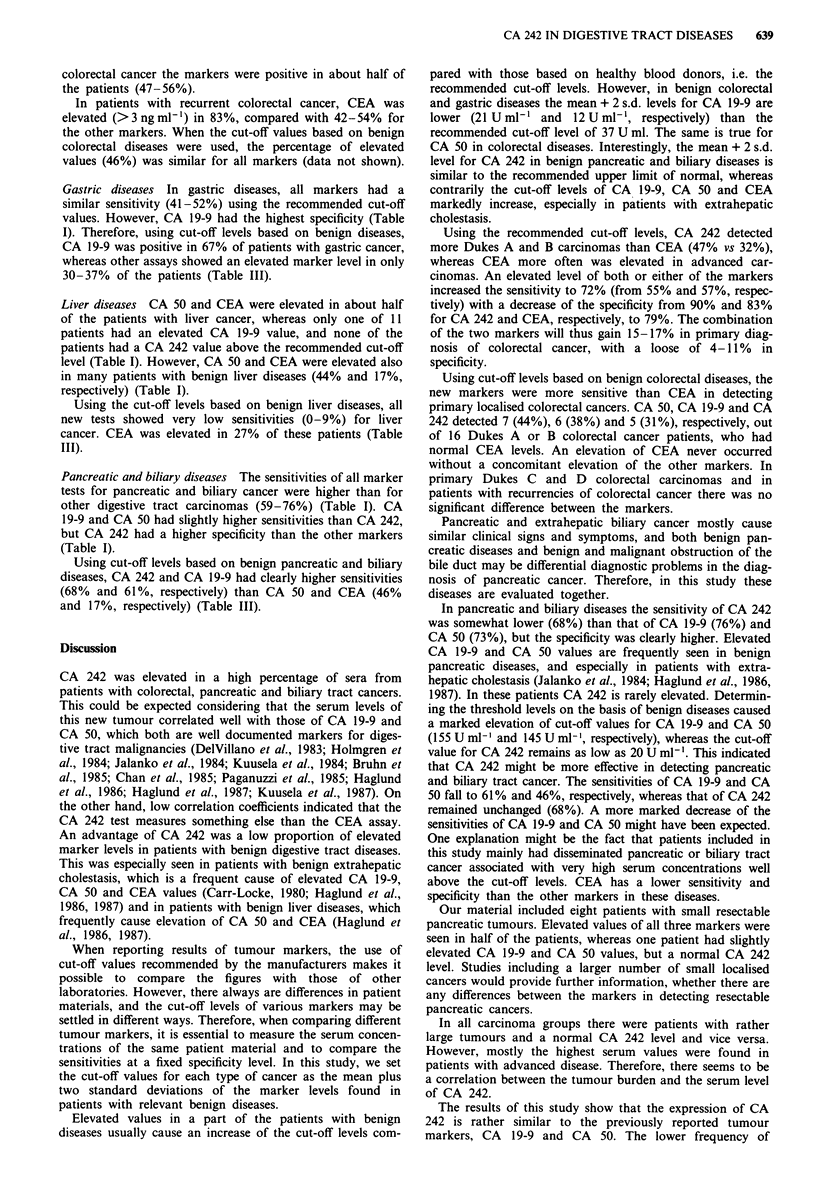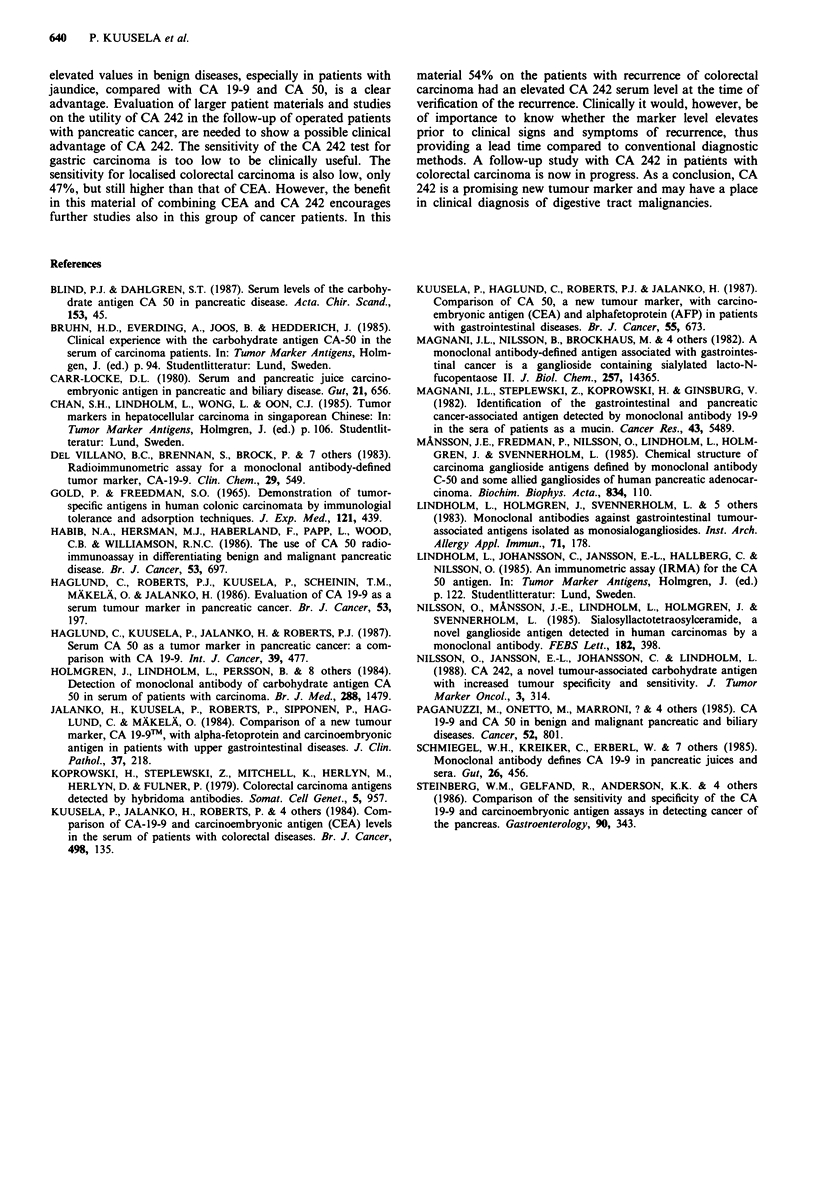Abstract
The levels of CA 242, a new tumour marker of carbohydrate nature, were measured in sera of 185 patients with malignancies of the digestive tract and of 123 patients with benign digestive tract diseases. High percentages of elevated CA 242 levels (greater than 20 U ml-1) were recorded in patients with pancreatic and biliary cancers (68%). The sensitivity was somewhat lower than that of CA 19-9 (76%) and CA 50 (73%). On the other hand, in benign pancreatic and biliary tract diseases the CA 242 level was less frequently elevated than the CA 19-9 and CA 50 levels. The serum CA 242 concentration was increased in 55% of patients with colorectal cancer. CA 242 detected more Dukes A-B carcinomas (47%) than CEA (32%), whereas CEA was more often elevated (71% vs 59%) in Dukes C-D carcinomas. CA 242 was slightly elevated (ad 41 U ml-1) in 10% of patients with benign colorectal diseases. CA 50 and CA 19-9 had lower sensitivities than CA 242 using the recommended cut-off values. When cut-off levels based on relevant benign colorectal diseases were used, the sensitivities of these markers were similar and somewhat higher than that of CEA. Less than half of patients with gastric cancer (44%) had an elevated CA 242 serum level. CA 242 is a promising new tumour marker, that may be of additional value in the diagnosis of pancreatic and biliary, as well as colorectal cancer, and may be useful in monitoring cancer patients after radical surgery.
Full text
PDF




Selected References
These references are in PubMed. This may not be the complete list of references from this article.
- Blind P. J., Dahlgren S. T. Serum levels of the carbohydrate antigen CA-50 in pancreatic disease. Acta Chir Scand. 1987 Jan;153(1):45–49. [PubMed] [Google Scholar]
- Carr-Locke D. L. Serum and pancreatic juice carcinoembryonic antigen in pancreatic and biliary disease. Gut. 1980 Aug;21(8):656–661. doi: 10.1136/gut.21.8.656. [DOI] [PMC free article] [PubMed] [Google Scholar]
- Del Villano B. C., Brennan S., Brock P., Bucher C., Liu V., McClure M., Rake B., Space S., Westrick B., Schoemaker H. Radioimmunometric assay for a monoclonal antibody-defined tumor marker, CA 19-9. Clin Chem. 1983 Mar;29(3):549–552. [PubMed] [Google Scholar]
- GOLD P., FREEDMAN S. O. DEMONSTRATION OF TUMOR-SPECIFIC ANTIGENS IN HUMAN COLONIC CARCINOMATA BY IMMUNOLOGICAL TOLERANCE AND ABSORPTION TECHNIQUES. J Exp Med. 1965 Mar 1;121:439–462. doi: 10.1084/jem.121.3.439. [DOI] [PMC free article] [PubMed] [Google Scholar]
- Habib N. A., Hershman M. J., Haberland F., Papp L., Wood C. B., Williamson R. C. The use of CA-50 radioimmunoassay in differentiating benign and malignant pancreatic disease. Br J Cancer. 1986 May;53(5):697–699. doi: 10.1038/bjc.1986.116. [DOI] [PMC free article] [PubMed] [Google Scholar]
- Haglund C., Kuusela P., Jalanko H., Roberts P. J. Serum CA 50 as a tumor marker in pancreatic cancer: a comparison with CA 19-9. Int J Cancer. 1987 Apr 15;39(4):477–481. doi: 10.1002/ijc.2910390412. [DOI] [PubMed] [Google Scholar]
- Haglund C., Roberts P. J., Kuusela P., Scheinin T. M., Mäkelä O., Jalanko H. Evaluation of CA 19-9 as a serum tumour marker in pancreatic cancer. Br J Cancer. 1986 Feb;53(2):197–202. doi: 10.1038/bjc.1986.35. [DOI] [PMC free article] [PubMed] [Google Scholar]
- Holmgren J., Lindholm L., Persson B., Lagergård T., Nilsson O., Svennerholm L., Rudenstam C. M., Unsgaard B., Yngvason F., Pettersson S. Detection by monoclonal antibody of carbohydrate antigen CA 50 in serum of patients with carcinoma. Br Med J (Clin Res Ed) 1984 May 19;288(6429):1479–1482. doi: 10.1136/bmj.288.6429.1479. [DOI] [PMC free article] [PubMed] [Google Scholar]
- Jalanko H., Kuusela P., Roberts P., Sipponen P., Haglund C. A., Mäkelä O. Comparison of a new tumour marker, CA 19-9, with alpha-fetoprotein and carcinoembryonic antigen in patients with upper gastrointestinal diseases. J Clin Pathol. 1984 Feb;37(2):218–222. doi: 10.1136/jcp.37.2.218. [DOI] [PMC free article] [PubMed] [Google Scholar]
- Koprowski H., Steplewski Z., Mitchell K., Herlyn M., Herlyn D., Fuhrer P. Colorectal carcinoma antigens detected by hybridoma antibodies. Somatic Cell Genet. 1979 Nov;5(6):957–971. doi: 10.1007/BF01542654. [DOI] [PubMed] [Google Scholar]
- Kuusela P., Haglund C., Roberts P. J., Jalanko H. Comparison of CA-50, a new tumour marker, with carcinoembryonic antigen (CEA) and alpha-fetoprotein (AFP) in patients with gastrointestinal diseases. Br J Cancer. 1987 Jun;55(6):673–676. doi: 10.1038/bjc.1987.137. [DOI] [PMC free article] [PubMed] [Google Scholar]
- Kuusela P., Jalanko H., Roberts P., Sipponen P., Mecklin J. P., Pitkänen R., Mäkelä O. Comparison of CA 19-9 and carcinoembryonic antigen (CEA) levels in the serum of patients with colorectal diseases. Br J Cancer. 1984 Feb;49(2):135–139. doi: 10.1038/bjc.1984.25. [DOI] [PMC free article] [PubMed] [Google Scholar]
- Lindholm L., Holmgren J., Svennerholm L., Fredman P., Nilsson O., Persson B., Myrvold H., Lagergård T. Monoclonal antibodies against gastrointestinal tumour-associated antigens isolated as monosialogangliosides. Int Arch Allergy Appl Immunol. 1983;71(2):178–181. doi: 10.1159/000233384. [DOI] [PubMed] [Google Scholar]
- Magnani J. L., Nilsson B., Brockhaus M., Zopf D., Steplewski Z., Koprowski H., Ginsburg V. A monoclonal antibody-defined antigen associated with gastrointestinal cancer is a ganglioside containing sialylated lacto-N-fucopentaose II. J Biol Chem. 1982 Dec 10;257(23):14365–14369. [PubMed] [Google Scholar]
- Magnani J. L., Steplewski Z., Koprowski H., Ginsburg V. Identification of the gastrointestinal and pancreatic cancer-associated antigen detected by monoclonal antibody 19-9 in the sera of patients as a mucin. Cancer Res. 1983 Nov;43(11):5489–5492. [PubMed] [Google Scholar]
- Månsson J. E., Fredman P., Nilsson O., Lindholm L., Holmgren J., Svennerholm L. Chemical structure of carcinoma ganglioside antigens defined by monoclonal antibody C-50 and some allied gangliosides of human pancreatic adenocarcinoma. Biochim Biophys Acta. 1985 Mar 27;834(1):110–117. doi: 10.1016/0005-2760(85)90182-1. [DOI] [PubMed] [Google Scholar]
- Nilsson O., Månsson J. E., Lindholm L., Holmgren J., Svennerholm L. Sialosyllactotetraosylceramide, a novel ganglioside antigen detected in human carcinomas by a monoclonal antibody. FEBS Lett. 1985 Mar 25;182(2):398–402. doi: 10.1016/0014-5793(85)80341-0. [DOI] [PubMed] [Google Scholar]
- Schmiegel W. H., Kreiker C., Eberl W., Arndt R., Classen M., Greten H., Jessen K., Kalthoff H., Soehendra N., Thiele H. G. Monoclonal antibody defines CA 19-9 in pancreatic juices and sera. Gut. 1985 May;26(5):456–460. doi: 10.1136/gut.26.5.456. [DOI] [PMC free article] [PubMed] [Google Scholar]
- Steinberg W. M., Gelfand R., Anderson K. K., Glenn J., Kurtzman S. H., Sindelar W. F., Toskes P. P. Comparison of the sensitivity and specificity of the CA19-9 and carcinoembryonic antigen assays in detecting cancer of the pancreas. Gastroenterology. 1986 Feb;90(2):343–349. doi: 10.1016/0016-5085(86)90930-3. [DOI] [PubMed] [Google Scholar]


